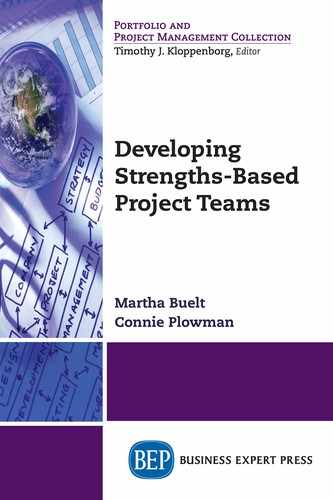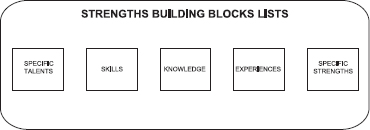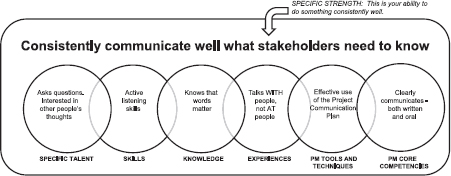Starting Point: Developing Your Strengths as a Project Manager
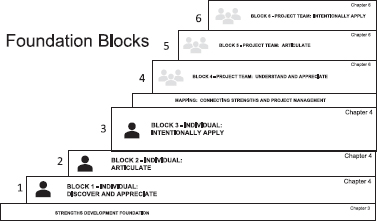
Strengths-based project teams start with the strengths of the project manager; therefore, to lead and manage a strengths-based project team, project managers need to first engage in their own individual strengths-based development. This chapter will guide you in the process of individual strengths-based development, much of which can also be applied to help project team members begin their individual strengths-based development.
Since this book is only the “tip of the iceberg” about strengths-based talent development and strengths-based project teams, we encourage you to explore the many resources available to you for more extensive and deeper individual strengths-based development information and processes. Check out the additional resources listed in Appendix A.
The purpose of this chapter is to help you:
1. Continue adding strengths development tools to your PM tool kit
2. Take the CliftonStrengths assessment
3. Use strengths development building blocks (presented in Chapter 3)
4. Discover, appreciate, and articulate your talents and strengths
5. Intentionally apply your talents and strengths
6. Use your strengths for leading and managing the project team
In Chapter 3, we presented the foundation blocks (Exhibit 3.5) for strengths development. Having started with foundational strengths-based development principles and tools (in Chapter 3), you are now ready to explore blocks 1, 2, and 3 in this chapter (Exhibit 4.1)—individual talent and strengths development.
Throughout this chapter, you will be learning about and using more strengths development tools. To fully engage in this chapter and future chapters’ objectives, you will need to create a “compartment” in your PM tool kit to keep and maintain your strengths development tools. In Chapter 2, we briefly defined a PM tool kit as “a unique combination of specific project management knowledge, experiences, skills, concepts, approaches, techniques, tools, and resources that the team member has acquired, has learned to use, and continues to add to over time.” Your strengths development tools compartment in your PM tool kit can be a physical or electronic system of keeping track of strengths development exercises and processes that you are learning to use. Your strengths development tools compartment is also a place for you to retain your responses and reflections that you write and compile as you engage in strengths development exercises and processes. Appendix B has sample templates from exercises used in the book that will also be good tools to add to your strengths development tools compartment.
We encourage you to move through each of the following strengths-based development sections before moving on to the next section. Take time to absorb and assimilate this information for your project environment and learning style. Most of the tools will resonate with you, even though some may be somewhat challenging. If there is an exercise or process that is very frustrating for you, it is best to put the specific exercise/process aside and come back to it at another time.

Exhibit 4.1 Individual talent and strengths development
Just as talents and strengths are unique and specific for each person, how each person best engages in strengths development is also somewhat unique. As you engage in the strengths development process, you will be able to determine which strengths development tools work best for you.
CliftonStrengths (StrengthsFinder) Assessment
Where to begin? You start with yourself. To engage in individual strengths development, you will need to take the online CliftonStrengths talent assessment. A CliftonStrengths code can be purchased in two ways:
• Online at the Gallup website (www.gallupstrengthscenter.com)
• Gallup CliftonStrengths books, such as StrengthsFinder 2.0.
When you purchase your code online or begin to use a code from a Gallup book, you will also be given an opportunity to set-up your own Gallup Strengths Center account (username and password), which will give you access to resources and tools for your individual strengths development after you take the CliftonStrengths assessment. Once your code is purchased, follow the instructions at the website for taking the CliftonStrengths assessment. The following instructions may also be helpful:
• We know project managers are busy. Try to find at least 45 minutes of uninterrupted time to complete the web-based talent assessment.
• You will be presented with several pairs of potential self-descriptors and will be asked to choose which descriptor best describes you, as well as the extent to which it does or does not describe you. You are allotted 20 seconds for each question before the assessment will move on to the next question. Try not to think too hard about the questions and give your first gut response.
After you complete the assessment, you will be given your Clifton-Strengths Signature Themes—your top five dominant talent themes. Your top five themes give you a starting point in which to name your specific, unique talents, which are the foundations for your current and future strengths. Knowing your top five talent themes is a first step in being more intentional about using your talents and strengths when managing project teams and working with stakeholders.
Throughout this book, we will refer to your top five themes. Your top five themes are your top five dominant talent themes; however, you have more than five dominant themes. If you are interested in exploring more of your dominant talent themes, refer to the Gallup website to learn more about acquiring your 34 CliftonStrengths Theme profile.
STOP! At this time, we encourage you to put the book aside and take the CliftonStrengths talent assessment. Having your assessment results will make the following sections and chapters more relevant and informative.
Strengths Development Philosophy and Basic Building Blocks
If you purchase your CliftonStrengths assessment code at the Gallup Strengths Center website, you may have access to an electronic version of the book, StrengthsFinder 2.0, when you log in to your account main page. The introductory chapters of StrengthsFinder 2.0 are a good resource for further understanding strengths development philosophy and building blocks that were presented in Chapter 3. The last part of the Strengths-Finder 2.0 book summarizes each of the 34 CliftonStrengths Themes; however, initially it is best to focus on your own top five themes. As you engage in strengths conversations and learn about your other project team members’ top five themes, you can then look back at StrengthsFinder 2.0 to learn more about the other themes.
An additional resource for learning about the 34 CliftonStrengths Themes as aligned with project management is presented in Chapter 5 and Appendix C, which will give you another tool to add to your PM tool kit’s strengths development compartment to further understand and apply the themes to project management.
Discover, Appreciate, and Articulate Talents and Strengths
To fully engage in strengths development, a person first needs to be able to name their talents and strengths and see how their talents and strengths are already working in their everyday life—and on projects—before they move into the next step of intentionally applying their talents and strengths toward their current and future projects, goals, challenges, and tasks. The tools and exercises presented in this section are interrelated, interdependent, and will help you to engage in the processes of discovering, appreciating, and articulating your talents and strengths.
CliftonStrengths Reports
Your CliftonStrengths reports list and summarize your top five talent themes. You can always find your CliftonStrengths reports by signing into the website where you took your CliftonStrengths assessment.
Your Signature Themes Report lists your top five dominant signature themes—your top five Talent Themes—and a general summary for each of your top five themes. (These general summaries are the same general summaries found in the StrengthsFinder 2.0 book.) If you compare your Signature Themes Report with another person’s Signature Themes Report who shares one of your top five talent themes, the two of you will have an identical summary of that shared theme in your reports.
You also may have access to two additional reports: Your Strengths Insight Report and Strengths Insight and Action-Planning Guide. Because your top five dominant talent themes influence and complement each other, you are also given a Strengths Insight Report, which includes your personalized summaries for each of your top five talent themes. Each personalized theme summary considers the intensity of the theme and of your other top five themes, giving you a customized theme summary for each of your top five talent themes. Therefore, if you compared your Strengths Insight Report with another person’s Strengths Insight Report who shares one of your dominant talent themes, your summaries of the shared theme will be slightly different.
The summaries in the Strengths Insight Report and Strengths Insight and Action-Planning Guide are identical. The difference between these two reports is that the Strengths Insight and Action-Planning Guide also includes action items and questions to help you intentionally apply and develop your talents and strengths.
Using Your Reports:
• Print a copy of your Signature Themes Report.
![]() Read over your top five signature theme summaries in your Signature Themes Report. As you read through each theme summary, you will notice that some of the words and phrases in the summaries describe you; however, since these are general summaries, not all the words and phrases will describe you.
Read over your top five signature theme summaries in your Signature Themes Report. As you read through each theme summary, you will notice that some of the words and phrases in the summaries describe you; however, since these are general summaries, not all the words and phrases will describe you.
![]() To help you name your talents, you can highlight or underline words and phrases that describe you and use those words to help you articulate your unique and specific talents that stem from each of your top five themes. The words and phrases that you highlight indicate some of your specific talents.
To help you name your talents, you can highlight or underline words and phrases that describe you and use those words to help you articulate your unique and specific talents that stem from each of your top five themes. The words and phrases that you highlight indicate some of your specific talents.
![]() If you have highlighted your report in the past, consider highlighting your report again. The lifelong process of investing in talents and developing strengths often leads people to notice more of their talents; therefore, as you highlight your report again, you may notice additional talents as compared to the last time you reviewed your report.
If you have highlighted your report in the past, consider highlighting your report again. The lifelong process of investing in talents and developing strengths often leads people to notice more of their talents; therefore, as you highlight your report again, you may notice additional talents as compared to the last time you reviewed your report.
![]() Add your highlighted Signature Themes Report to your PM tool kit. Periodically review your talent theme summaries in your report. As you engage in lifelong strengths development, the report’s summaries may help you to notice more of your talents.
Add your highlighted Signature Themes Report to your PM tool kit. Periodically review your talent theme summaries in your report. As you engage in lifelong strengths development, the report’s summaries may help you to notice more of your talents.
• Print a copy of your Strengths Insight and Action-Planning Guide, if you have access to this report.
![]() Read over your summaries and reflect on the following questions:
Read over your summaries and reflect on the following questions:
![]() What do you think about these summaries? How well do the summaries describe you?
What do you think about these summaries? How well do the summaries describe you?
![]() Are there more words and phrases that resonate with you than in your Signature Themes Report? What are those words and phrases?
Are there more words and phrases that resonate with you than in your Signature Themes Report? What are those words and phrases?
![]() What further insights about your dominant talent themes did the summaries help you to discover?
What further insights about your dominant talent themes did the summaries help you to discover?
![]() How do these summaries resonate with you as a member of a project team?
How do these summaries resonate with you as a member of a project team?
![]() Add your Strengths Insight and Action-Planning Guide to your PM tool kit. You will use this report again when you engage in the application step of strengths development.
Add your Strengths Insight and Action-Planning Guide to your PM tool kit. You will use this report again when you engage in the application step of strengths development.
Tabletop Name Card
You want to see and have others see your top five themes. You can make a simple tabletop name card using cardstock and a marker. Fold a sheet of cardstock in half or in thirds to make your tabletop name card stand upright on a table—it will look like a triangular tent. Your tabletop name card has two sides: a front and a back. Write your first name and your top five talent themes on each side:
• On the front of the card so that others can see your name and themes.
• On the back of the card so that you can see your own themes which will help you to learn and remember your top five themes.
Place your tabletop name card on your desk, carry it with you to meetings, and use it as you engage in one-to-one strengths conversations.
Strengths Building Blocks Lists (Your specific talents, knowledge, skills, experiences, and strengths lists).
Exhibit 4.2 Strengths building blocks lists
In Chapter 3, we defined talents, knowledge (factual/conceptual), experiences, and skills and explained that these are the major components for building strengths. As you begin being more intentional about building your strengths, create and maintain lists for each of your specific talents, knowledge, experiences, skills, and specific strengths and keep the lists in your PM tool kit (Exhibit 4.2).
Where to begin? Here are some ways to get started on your lists:
• You have just highlighted words and phrases—your specific talents—in your Signature Themes Report. Keep track of those specific talents that you identified on your Specific Talents List.
• You have already started your Specific Strengths List. Remember in Chapter 1, you wrote down three things that you do consistently well. Use the three things you listed to start your Specific Strengths List.
• Take some time to think about and list the general skills, knowledge, and experiences that you have acquired over your lifetime.
• In addition, think about the specific project management conceptual knowledge, skills, and experiences that you have acquired and list those. Also list your areas of expertise.
The Strengths Building Blocks Lists (Exhibit 4.3) you are making are brainstorming lists: there is no specific order to the content you are adding, and there may or may not be any connection between the items in each list or between lists. Freely think about the specific knowledge, skills, and experiences you have acquired over your lifetime, the specific talents you were born with, and the things that you do consistently well right now (your current strengths).
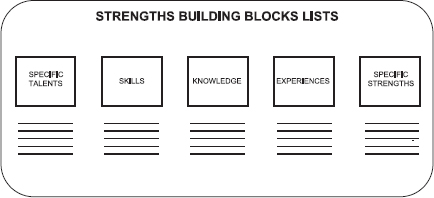
Exhibit 4.3 Working document for your Strengths Building Blocks Lists

Exhibit 4.4 Strengths building blocks lists (project management example)
Here is a specific project management example using the working document template (Exhibit 4.4):
As you enter into the next processes and exercises in this section and chapter, you will use and add more to your Strengths Building Blocks Lists. Keep your Strengths Building Blocks Lists in the strengths development compartment of your PM tool kit. Later, you will intentionally use some of your list’s content to help you articulate how you developed your existing strengths and how you want to intentionally further develop your strengths.
What if you are not a “list” person? Use this list process to get started. Then as you engage in the process, you may develop a better system to keep track of your specific talents, knowledge, skills, experiences, and specific strengths. This is part of the creativity we discussed earlier about tailoring this book’s approaches and information to fit your needs and style.
A Talent Theme a Day
• Choose one of your top five dominant talent themes.
![]() The First Day: As you go through your day, notice how you naturally use the talents from that theme. At the end of the day, write down the specific talents within this theme that you used during the day.
The First Day: As you go through your day, notice how you naturally use the talents from that theme. At the end of the day, write down the specific talents within this theme that you used during the day.
![]() The Next Couple of Days: Find two ways to intentionally leverage the specific talents (that you named yesterday) to complete some of your assigned deliverables or tasks today. Continue this process for a few days—strengthening your ability to use talents from the theme you chose on the first day.
The Next Couple of Days: Find two ways to intentionally leverage the specific talents (that you named yesterday) to complete some of your assigned deliverables or tasks today. Continue this process for a few days—strengthening your ability to use talents from the theme you chose on the first day.
![]() Add to your Strengths Building Blocks Lists: Add the specific talents you named and ways you used these talents to your Specific Talents List (one of your Strengths Building Blocks Lists) that you keep in the strengths development compartment of your PM tool kit.
Add to your Strengths Building Blocks Lists: Add the specific talents you named and ways you used these talents to your Specific Talents List (one of your Strengths Building Blocks Lists) that you keep in the strengths development compartment of your PM tool kit.
• Repeat the Process: In a few days, start this step-by-step process with another one of your dominant talent themes.
When you practice using your talents in the “a talent theme a day” process, you are investing in your talents and developing your strengths by gaining experiential knowledge, one of the ingredients for developing a strength.
Keep track of what you learn from the “a talent theme a day” process, because the specific talents you name and the ways in which you use them will also help you to further engage in a subsequent strengths development step of intentionally applying your talents and strengths.
Holding-Up the Mirror1
Our dominant talents are such a natural part of who we are, that sometimes we don’t see them and/or appreciate their value. People who know us well can often see our talents and their value better than we can. Share your top five talent themes with a person who knows you well. This might be someone on your project team, your project sponsor, a colleague, or someone outside the project.
Take this learning opportunity to describe your top five talent themes to this person, and then ask them to tell you where he or she has seen your talents from these themes working in your life. Take some notes about the insights you gain from this conversation and consider adding what you learn to your Strengths Building Blocks Lists.
Strengths Conversations
The holding-up the mirror activity is one form of a strengths conversation. Since people don’t develop and use their talents and strengths in isolation, you need your project team members—and your team members need you—to fully engage in strengths development. Strengths conversations are tools and practices that you and your team members can use to help one another engage in strengths development. Strengths conversations are simply conversations around talents and strengths, which equip people to better articulate their talents, invest in their talents, further develop their current strengths, and apply their strengths.
With whom can you engage in strengths conversations? Everyone! At work, at home, in your community. Even with people who don’t know about strengths development, strengths conversations give you the opportunity to tell them about talents and strengths. That said, strengths conversations will be easier to have with people who have at least a general strengths development background. Therefore, equipping your project team with the basics of strengths development will equip you and the project team to better engage in strengths conversations. As you take the initial steps for engaging in your own individual strengths development, first engage in strengths conversations with your functional manager and your peers.
Where at work can you engage in strengths conversations? In all contexts. Once your project team members understand strength development, you will be able to weave strengths conversations into your project team meetings, project status meetings, one-on-one meetings and conversations with your project team members or project sponsor, and casually at lunch or during a break.
The time commitment for strengths conversations vary, especially as individuals, teams, and organizations begin strengths development. However, once a strengths-based project team and/or organizational culture is established, strengths conversations can be effective in as little as just a few minutes.
Looking ahead: Why are strengths conversations essential for strengths-based project teams? Strengths conversations are key for maximizing the application of your own strengths and the collective strengths of your project team members and instrumental for making effective project team decisions. For example, on the project team, who has the strength(s) to best lead or complete a particular deliverable or major task? How can the project team best approach one of their specific project team challenges?
As you prepare to best maximize the collective strengths of your team, it is essential that you communicate your talents and strengths to your project team, what you need, what motivates you, what you like and don’t like, and how you can best lead the project team. In turn, you need to understand the talents and strengths of your project team members, what your team members need, what motivates them, what they like and don’t like, and how they can best contribute to the project team. In subsequent chapters, we will further expand upon how to practice strengths conversations with your project team.
Strengths Partnership
Having a strengths partner will help you to engage in strengths conversations about your own and your partner’s talents and strengths. Find a partner who is also interested in strengths development. Try to meet with your strengths partner once or twice a week for 20 minutes for a strengths conversation. Your strengths conversations can be simple, such as sharing your discoveries and insights from the individual strengths development exercises and processes listed in this chapter. You can also use strengths conversational ideas and prompts found in Appendix D.
Talents and Strengths Grid (Articulating Talents and Strengths)
As you discover and articulate your talents and strengths, keep track of them in a Talents and Strengths Grid (Exhibit 4.5). You will also use this grid later in the strengths application step.
The following steps will help you complete the grid for your talents and strengths.
Step One: Dedicate a row of the grid to each of your existing strengths and list each of your current strengths in a box in the column marked “Strength: My Specific Strength.” See Exhibit 4.6. (When you are finished, each box under “strength” will contain one of your current strengths.) Remember, a strength is something that you do consistently well. To get you started, fill out the first three “strengths” boxes (in the column marked “My Specific Strength”) with the strengths that you listed in Chapter 1.
Exhibit 4.5 My talents and strengths grid: template
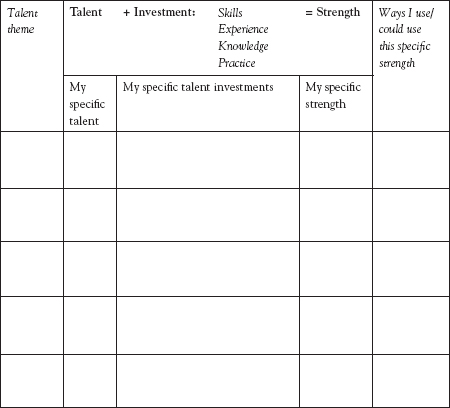
Exhibit 4.6 My talents and strengths grid: Specific strength
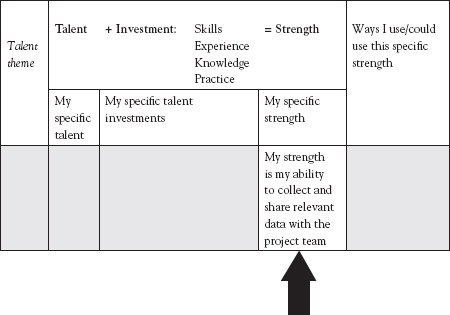
Step Two: Also dedicate a row of your grid to each of your specific talents and list each of your specific talents in a box in the column marked “Talent: My Specific Talent.” (Each box under “Talent” will contain one of your natural talents.) Remember, a talent is a way that you naturally think, feel, or behave. Use your highlighted Signature Themes Report to get you started. The words you highlighted are descriptors of your talents.
If you use your report to articulate your talents, you will also be able to list the talent theme that your specific talent is anchored in. Put the name of the theme in the column next to the “Talent: My Specific Talent,” as shown in Exhibit 4.7.
If you articulate some of your specific talents without using your report (articulating your talents “organically”), you still have the option of including the talent theme you think your specific talent is anchored in; however, you do not have to write down a talent theme in the respective row. On the other hand, feel free to write down more than one talent theme if you see your specific talent anchored in more than one talent theme.
For now, you can leave the “Investment” column blank (Exhibit 4.8). The grid’s purpose now is to help you to create a list of your specific talents and strengths, which you can intentionally use later when you engage in the application step of strengths development.
Exhibit 4.7 My talents and strengths grid: Talent theme with specific talent
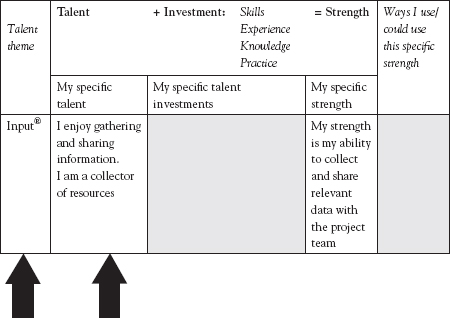
This grid is for you. There is no right or wrong way to use this grid. The instructions listed here are to get you started. As you use this grid, you may develop new approaches to keeping track of your specific talents and specific strengths.
Exhibit 4.8 My talents and strengths grid: Investments (blank)
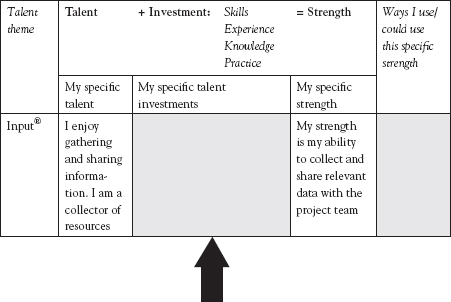
Give the grid a try. It is a terrific tool for organizing, tracking, and showing progress! We will be referring back to this grid later in this chapter. As you move forward in strengths development, continue to add to and refer to your Talents and Strengths Grid.
Intentionally Apply Talents and Strengths
Since you have discovered, appreciated, and articulated your talents and strengths, you are ready to engage in the application of your talents and strengths. Often, people skip the strengths-development “application” component because it can be challenging; however, just like discovering, appreciating, and articulating your talents are essential components of strengths development, intentionally applying your talents and strengths is also essential! Strengths-based development is more than just knowing about your talents and strengths—it’s also about maximizing and using your talents and strengths in your role as you work with others, including working with your project team members.
In Chapter 3, we explained key purposes for intentionally applying talents and strengths:
• Invest in talents to develop strengths
• Leverage strengths
• Continue developing existing strengths
The following application exercises will help you to begin being intentional about applying your talents and strengths. Although the exercises are presented in connection with the key application purposes, the exercises are also interrelated.
Invest in Talents to Develop Strengths
The following two exercises will guide you in the process of being more intentional about investing in your specific talents.
Strengths Insight and Action-Planning Guide (CliftonStrengths Report)
1. Look over your Strengths Insight and Action-Planning Guide, if you have access to this report.
2. In the “Awareness” section, read your customized talent theme summaries again and reflect on the section’s questions.
3. In the “Application” section, you will find a list of action items connected to each of your top five talent themes.
(a) Choose one or two specific action items from one talent theme to help you invest in your talents and develop your strengths.
i. Focus on your chosen action item(s) for a few days.
ii. Take some notes about your experience with each action item.
iii. Can you add more insights to your strengths building blocks lists? To your talents and strengths grid?
(b) After a few days, choose an action item(s) from another talent theme.
Talents and Strengths Grid
Your talents and strengths grid can help you keep track of your ideas for developing your talent potential and ways that you have already successfully invested in your specific talents.
1. Pull out your Talents and Strengths Grid. Designate a new row on your grid for this exercise.
2. Look at your specific talents that you have articulated so far in the “Talents: My Specific Talents” column on your Talents and Strengths Grid. Also look at your Specific Talents List you have made.
3. Choose one of your specific talents and insert the specific talent in a new row on the grid.
4. Is there a potential strength that you would like to develop from the specific talent you chose? Articulate and include the strength that you want to develop in the same row as the specific talent you just included in your grid.
5. What are some ways that you would use that strength? Include your insights in your grid under “Ways I use/could use this specific strength.”
6. Brainstorm ways you could invest in your specific talent to get to the strength you would like to develop. Under the “investment section” of your grid, include your insights in the same row to which you just added the specific strength that you want to develop.
7. You are using your grid to articulate ways that you could be intentional about investing in your talents to develop your strengths. Create a Developing Strengths Action Plan to keep track of the ways that you will invest in your talents.
Exhibit 4.9 gives you an example of what a partially completed grid might look like.
After you use your grid to name specific ways that you could invest in your talent to develop a strength, consider color-coding or creating a system for your grid which would indicate strengths you have developed and strengths you are currently developing. Remember, this grid is yours—how you develop and use this grid will be unique for you.
Your grid will help you to articulate the several elements that can come together over time to form a strength: What goes into a strength? How can I develop this strength?
Here is another specific project management example and template for developing and/or articulating a strength. All project managers need to be able to communicate well. In this example, a project manager has combined his unique, specific talent(s) with his acquired skills, knowledge, experiences, and project management tools, techniques, and/or core competencies to develop a strength to be able to communicate well. He describes his specific strength as having the ability to “consistently communicate well what stakeholders need to know.”
This project manager does not have dominant Communication® talents; however, he chose to invest in one of his dominant, specific talents—his natural “interest and inclination to ask questions to learn about what others are thinking”—to develop the ability to “consistently communicate well what stakeholders need to know”—his specific strength.
Exhibit 4.9 My talents and strengths grid: Completed example
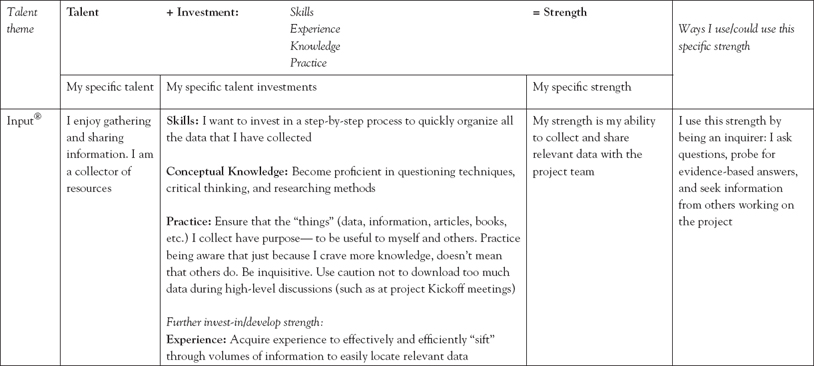
Exhibit 4.10 Example of strengths building blocks lists
His peers may also have developed specific strengths for being an excellent communicator but how they develop their strengths and how they articulate their specific “excellent communicator” strengths will vary depending on what their specific talents are.
Exhibit 4.10 shows how the project manager in our previous example invested in his specific talent over time to develop his specific strength.
Just like the talent and strength grid is unique to you, the “circles” or elements that make up your strength will also be unique to you.
Leverage Strengths Toward Tasks and Challenges
How can you best use your strengths? As an individual? As a project manager? And a project team member? Consider these four steps to get started:
1. Make a list of your tasks and challenges:
(a) What tasks are you currently responsible for?
(b) What challenges are you facing right now?
2. Choose one task or challenge.
3. Using your Strengths Building Blocks Lists and your Talents and Strengths Grid, think about what strengths you can leverage toward your chosen task or challenge.
(a) Which of your strengths do you think you could leverage in this situation?
(b) Have you used a specific strength toward a similar task or challenge in the past? Did using that strength result in success? Could you leverage this strength in this situation?
(c) Is there a person with complementary strengths who you could partner with as you leverage your strengths in this situation?
4. You are articulating ways that you could be intentional about leveraging your strengths. Create a Professional Development Plan for how you plan to complete the task or approach the challenge, including ways that you can use some of your specific strengths. (You will find a template for a Professional Development Plan in Appendix B.)
By creating your Professional Development Plan, you will now have a roadmap to guide you in intentionally applying your strengths. In Chapter 8, you will learn more about using a Professional Development Plan.
Leverage Your Strengths to Work with Others
The effect of using your strengths grows exponentially when you leverage your strengths in collaboration with others.2 How can you get started leveraging your strengths in collaboration with others on a project team? Here are some first steps:
1. Post Your Top Five Talent Themes near your desk (e.g., table top name card you made earlier), in your email signature block, or on the project team’s virtual “white board.”
2. Engage in Strengths Conversations with your functional manager, your peers/colleagues, and other team members.
3. Form Complementary Partnerships with your colleagues and project team members.
4. Look for Talents and Strengths in Motion from your colleagues and project team members. When you see one of your colleagues or project team members using their talents and strengths, tell them! It can be a simple note that you leave on their desk or a simple verbal accolade. If you are working on a global project team, consider the different country cultures for sharing this information. The benefits of looking for talents and strengths in motion include:
(a) Injects positivity into your workplace
(b) Lets your colleagues and project team members know that you noticed their good work
(c) Holds-up the mirror for your project team members—they may not be aware of the talents and strengths that they have
(d) Promotes strengths conversations on the project team
(e) Affirms and sustains a strengths-based project team culture
(f) Celebrates the successes of the project team—no matter how small
Continue Developing Existing Strengths
As you continue to discover and articulate your current strengths, add your strengths and how you developed them to your Talents and Strengths Grid and your Strengths Building Blocks Lists. Identifying your existing strengths and then how you developed those strengths will help you to further develop your current strengths.
1. Choose one of your current strengths (from your grid or lists).
2. If you have not done so, use your grid to write down ways that you already use this strength.
3. Try to name and add to your grid a specific talent and its respective talent theme that you invested in (intentionally or unintentionally) to develop this specific strength.
4. What specific skills, knowledge, and experiences did you acquire to develop that specific strength? Add those to your grid.
5. Think about and articulate ways that you could further develop this specific strength. Add these ideas to your grid.
6. Use your Developing Strengths Action Plan to keep track of the ways that you will continue to develop your existing strengths.
Use Your Strengths to Lead and Manage the Project Team
As a project manager, it is your role to lead and manage the project team. How you can best fulfill your specific project manager role depends on your talents and strengths; therefore, it is to your advantage to consider and articulate specific ways to leverage your strengths as you lead and manage your team.
How can you be more intentional about leveraging your strengths in your project manager role? You have already practiced using some processes for intentionally applying your talents and strengths. You have started a Professional Development Plan and created a Developing Strengths Action Plan. Now, you can maximize the talents and strengths application process to dive deeper into your specific project management strengths and the strengths you want to further develop:
1. Articulate three of your tasks or challenges that you have in your project manager role.
2. Pull out your Strengths Building Blocks Lists and Talents and Strengths Grid. Think about ways in which you could apply your strengths toward each of the three tasks or challenges you named. List your ideas.
3. Are there strengths that you could also develop or further develop to leverage toward your chosen tasks or challenges?
(a) What specific strength do you want to develop? What specific talent(s) would this strength be anchored in?
(b) What additional project management tools do you need to acquire to develop the strength you identified earlier?
i. What trainings could you attend?
ii. How can you practice and apply what you learn in training to gain experience for further developing your strength?
4. Articulate one or two action items for applying your strengths to your tasks or challenges and include in your Professional Development Plan. If you have specific strengths to develop, include how you will develop those strengths in your Developing Strengths Action Plan.
Give yourself time to “experiment” with this process of intentionally investing your project management knowledge, skills, and experiences into your talents and strengths.
Keep in mind that the strengths you develop from acquiring specific project management knowledge, techniques, and tools may look different compared to another project manager who acquires the same knowledge, techniques, and tools. How each of you best carries out your role as a project manager will vary depending on your talents and strengths even with the same tool kit. In addition, you are each working on different projects and with different team members with different talents and strengths. Therefore, in addition to learning from other project managers, be sure to experiment with the strengths you have developed in your various project management roles and use your unique strengths to maximize your effectiveness and success as a project manager.
Summary
Strengths-based project team development begins with the project manager’s individual strengths development. The best strengths development “storage” are compartments in your PM tool kit where you can keep and maintain your strengths development tools plus track your progress and reflections. Start by taking the CliftonStrengths assessment to obtain your top five dominant talent themes. After taking the assessment, continually use the information in your CliftonStrengths reports to further develop your strengths.
Leverage the exercises presented in this chapter for your individual strengths development. Use your knowledge of strengths development building blocks to discover, appreciate, articulate, and apply your talents and strengths. Strengths-based development is knowing, maximizing, and using your talents and strengths in your role on a project team. The strengths development tools you have added to your PM tool kit prepares you to begin to guide your project team members in individual and project team strengths development. It starts with you!
Key Questions
1. What was your first impression of your top five talent themes in your Signature Themes Report?
a. Did any part of your report surprise you?
b. Did you discover any new ways to articulate your talents?
c. Is there any part of the report that you have questions about?
2. You have articulated some of your strengths through the exercises in this chapter. Look over your list and then answer the following questions:
a. What do you like about being able to apply your strengths in your project manager role? What about the application process do you want to learn more about and practice?
b. Give an example of how you currently use one of your strengths in your current project management role. Then think about and articulate ways that you could use your other strengths in your current project management role.
3. How can using the talents and strengths grid benefit you? Then think about your project team: How could your project team benefit if each team member uses the grid?
Notes
References
PMBOK® Guide. 2017. A Guide to the Project Management Body of Knowledge, 6th ed. Newtown Square, PA: Project Management Institute.
Winseman, A.L., D.O. Clifton, and C. Liesveld. 2008. Living Your Strengths. New York, NY: Gallup Press.
